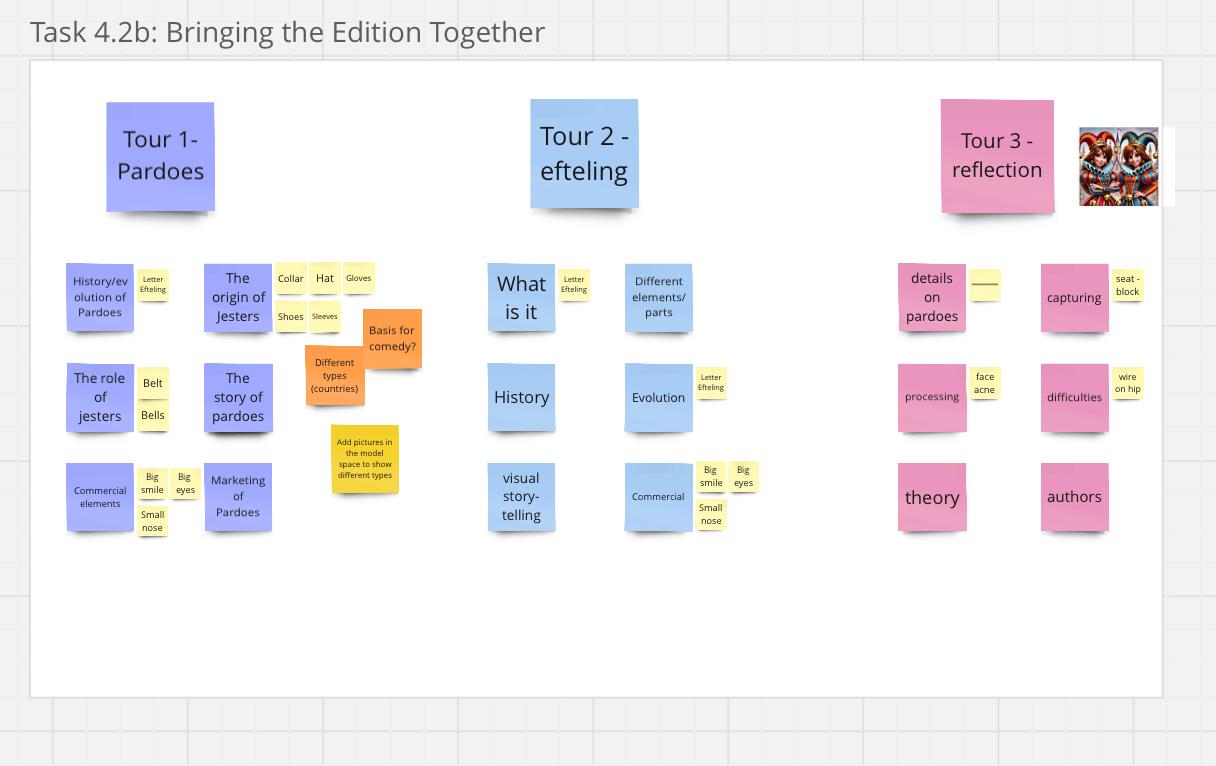
It was an exciting, though challenging experience working with Voyager to develop 3D tours of Pardoes, Efteling's mascot. Voyager, a 3D software package for developing interactive, scholarly editions, allowed us to recreate the history, design, and development of Pardoes in a virtual setting. However, the highly visual nature of the software and the atypical interface demanded painstaking attention to detail and a lot of time.

This is one of our first Miroboards, which shows our initial ideas for annotations of Pardoes
The tour design in Voyager was iterative. Tour 1 was a historical approach describing how Pardoes was developed, and how the mascot has evolved. Tour 2 examined the theme park behind Pardoes, its history, and the storytelling aspect of the park which is a huge part of Pardoes. Tour 3 discussed the technical process of creating a 3D model of Pardoes, the problems, and the approach of photogrammetry. All of the tours required careful planning of content placement, 3D object placement, and that the tour logically flowed for the user. Annotations, which provided detailed descriptions, were important to guide the user through the experience and give additional insight into each piece.

The Miroboard displaying our tour designs
Voyager's interface is designed to give a highly visual experience, allowing people to interact with 3D models and surrounding content. But every design decision was made considering the final user, ensuring that the information could be understood, easily found, and appealing. Given the visual nature of the platform, designing each element required constant refinement to ensure a seamless user experience. Voyager was time-consuming given the fact that it has a lot of features, and you need to know your way around their interface. The fact that the tours had a high degree of interaction involvement meant that each task, from placing objects to adjusting annotations, was time-consuming. Each tour was made to present effectively encapsulated attention to structure, content flow, and user interface, which we sketched in Google Slides.
Challenges Faced
A major problem was the coordination required when working in Voyager. Since the system does not allow more than one person to work in the software at a time, it became impossible to see each other's work in progress. This could result in one person's work being overwritten if they saved while the other was still making changes. To prevent this, we established a strict rule from the start: members had to give notice when they started and finished work. This way, we could avoid accidental data loss and maintain a smooth workflow.
We also experienced some technical issues, like crashes that deleted all our work, when uploading 3D models in glb format. One of the error messages, "Document schema validation failed," would pop up when files contained spaces or special characters. We were able to bypass this initially by uploading files with shortened names, but when the problem resurfaced later in the process when we had already completed most of our tours. We needed to search for external help to revert the file to our initial version, and it consumed a lot of time and halted progress.

The error notification we received a few times while working in Voyager
Additionally, there were issues with the annotations. Some annotations would conceal significant parts of the 3D model, and users could not simply navigate through it. Adjusting the positions of these annotations was a time-consuming process, and it had to be carried out with great caution.
In conclusion, while the collaboration within Voyager did produce a novel approach to depicting the 3D layout of Pardoes, it also came with challenges. The combination of technical problems, language differences, and the laborious design process made it a long but rewarding process. Through collaboration and careful coordination, we were able to overcome these challenges and bring the vision of Pardoes to life.